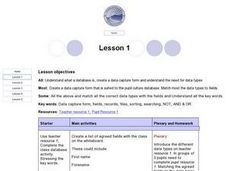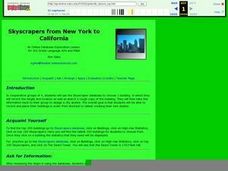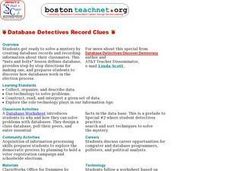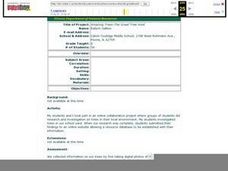Curated OER
Doughnuts to $ Database
Fifth graders are selling Krispy Kreme doughnuts to raise money for their overnight camping trip. They use a database to set to keep track of and record additions to their daily sales. Students then follow the step by step directions to...
Curated OER
California Missions
Fourth graders use what they already have gathered on California missions to create a database. Using the different missions, they brainstorm, organize and categorize what they have gathered. They present their material to the class and...
Curated OER
Creating a Thematic Map
Students create and analyze a weather-related data table and a thematic map based upon information provided.
Curated OER
Database
Second graders collect daily weather information and introduce them to databases.
Curated OER
The 50 States
Fifth graders use a database to gather information on the United States. Using this information, they try to describe the settlement patterns in the various states. They enter additional information into the database and use queries to...
Curated OER
How Are Plants Similar And Different?
Studetns create an index card database of different categories of plants such as bushes, trees, flowers, grasses and vegetables. They review the different parts of a plant and label pictures of plants on the database cards. They use the...
Curated OER
Technology Integration
Third graders describe and locate the five geographical regions of the state of Virginia. Using that information, they organize the descriptions in a database they created. They are graded based on accuracy and spelling all noted on a...
Curated OER
What Does George W. Bush Have in Common With Past U.S. Presidents?
Sixth graders discover what it takes to become President of the United States. Using a database, they complete a scavenger hunt to determine what George W. Bush has in common with past Presidents. They also create a spreadsheet which...
Curated OER
Food Chain
Fourth graders use a database on animal diversity to complete the lesson. Using the information, they discover how organisms are linked to one another by their dependence on each other for food. In groups, they develop their own food...
Curated OER
Skyscrapers from New York to California
Third graders use an online database to gather information on skyscrapers. Using the information, they choose one building and record its height and location. In groups, they design a city skyline including the skyscraper they choose....
Curated OER
Get Ready For Some Football
Sixth graders compare and contrast the totals from two national football teams for the year. Using the internet, they search for the information they need and create a data bar graph. They use the information they collected to answer...
Curated OER
From Curiosity Cabinet to Museum Collection
Learners study binomial nomenclature and museum-based research. They create a curiosity box, label the objects in their curiosity box , develop a classification scheme for the objects, and create a database of all objects collected by...
Curated OER
Database Detectives Record Clues
Students collect and organize data from their classmates. They create a database of the information and analyze it. They discuss the role technology has in the world today.
Curated OER
Burning It Up
Students explore energy as it relates to body function. Data about the personal physical activity of students is gathered and entered into a database which is utilized to test hypotheses made.
Curated OER
Candy Database
Students make a database of their Halloween candy and decide which types are the healthiest. In this diet lesson plan, students make written data charts using their candy, locate dietary information on one type, sort the candy by shape,...
Curated OER
American Colonies
Students record information in a database about the three American colonies. They are comparing and contrasting them. They are to log into a given database and fill in the corresponding sections. Once it is filled in the similiarities...
Curated OER
Human Genetic Traits
Young scholars investigate dominant and recessive traits by studying their schoolmates. In this genetics lesson, students analyze specific traits of other children in school and create a database of information based on whom...
Curated OER
Constructivist Theory
Students in a teacher education program are introduced to the constructivist theory. In grade level teams, they take their subject matter focus and create lesson plans related to the constructivist theory. They are graded with a rubric...
Curated OER
Artfully Searching for Treasure
Search for artwork using online museum databases. Young artists will create their own online art treasure hunts based on a specific theme and set of criteria.
Curated OER
Using a Database in Science Experiments
Fifth graders plant and take care of a lima bean plant and make predictions on its growth. In this science lesson, 5th graders chart their records and make conclusions about their experiment.
Carolina K-12
Preventing Voter Fraud or Encouraging Voter Suppression?
The issues of voter fraud and voter suppression are relevant in every election, local as well as national. Soon-to-be voters learn about a recent bill proposed in North Carolina, the Voter Information and Verification Act, and...
Curated OER
Science: The Great Tree Hunt
Sixth graders participate in an online, cooperative project researching trees in their local environments for use in an online knowledge game. They take digital pictures of the trees, bark, and leaves. After completing their research,...
Curated OER
Genetic Traits
Students supplement their study of genetics by collecting and analyzing information about their own and their classmates' characteristics and traits. Students create a database of traits and characteristics to compare and contrast.
Curated OER
What About That Jazz?
Students, with the help of the NBA Utah Jazz website, formulate how to use a database. In addition, they access how to copy and paste, and prepare a spreadsheet for later use. Students apply productivity/multimedia tools and peripherals...























